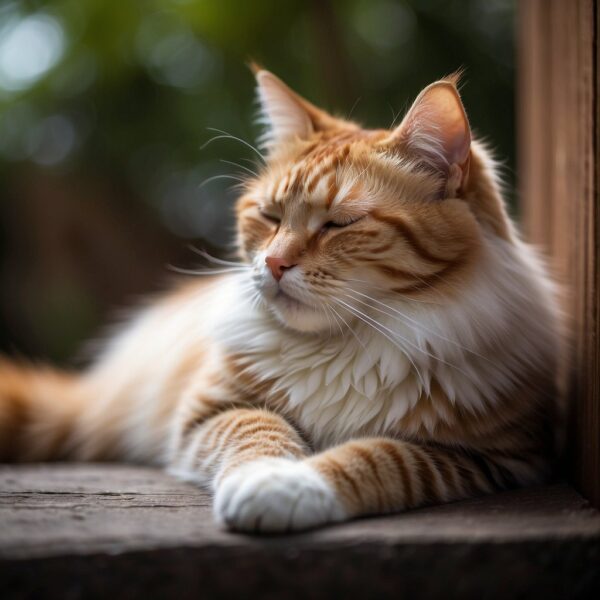
Do Cats Dream: Understanding Feline Sleep Patterns
Considering the complex behaviors and the depth of personality observed in domestic cats, it’s common for cat parents to wonder whether their feline companions dream.
Like their human counterparts, cats go through sleep cycles that include both Rapid Eye Movement (REM) and Non-REM sleep.
REM sleep is often associated with dreaming in humans, and it’s during this stage that cats too exhibit signs that suggest they could be dreaming.
The exact content of a cat’s dreams is, of course, a subject of speculation as cats cannot share their experiences.
However, scientific observation of their physical behaviors during REM sleep suggests that they do experience dreams.
Physical movements such as twitching whiskers, paws paddling as if running, and subtle facial movements mimic behaviors that are typically associated with dreaming in other species, providing evidence that cats have dream-like states.
Key Takeaways
- Cats experience REM sleep, where dreaming in animals typically occurs.
- Physical movements observed in cats during REM sleep imply they may dream.
- The content of a cat’s dream remains speculative but aligns with common dream behaviors seen in other dreaming animals.
Understanding Cat Sleep
Cats experience two main types of sleep: rapid eye movement (REM) and non-REM.
During their sleep cycle, cats alternate between these two states just as humans do.
The non-REM phase constitutes the majority of their sleep, which includes the deep sleep required for physical restoration.
When cats enter the REM sleep phase, they exhibit characteristics similar to dreaming.
Observations suggest that cats experience twitching of whiskers or paws during this stage, indicating possible dream activity.
This phase is shorter and occurs sporadically, which may correspond to the visual or instinctive dreams noted in anecdotal reports.
The pattern of a cat’s sleep is flexible, adjusting to their environment and routine. However, they tend to favor short, frequent bouts of slumber, known as polyphasic sleep patterns.
Here is how their typical daily sleeping habits divide:
- Daytime: Predominantly for shorter, light naps.
- Nighttime: More extended periods of rest, which can include deep sleep.
Relative to total sleep time, a considerable amount occurs during daylight hours, reflective of their crepuscular nature – being most active during twilight.
| Cat’s Sleep State | Characteristics |
|---|---|
| Non-REM | Deep restorative sleep, body rejuvenation |
| REM | Possible dream state, noticeable movement |
Understanding a cat’s sleep is essential for promoting their well-being and considering behavioral patterns tied to their natural instincts. This insight contributes to a harmonious living arrangement and better care for feline companions.
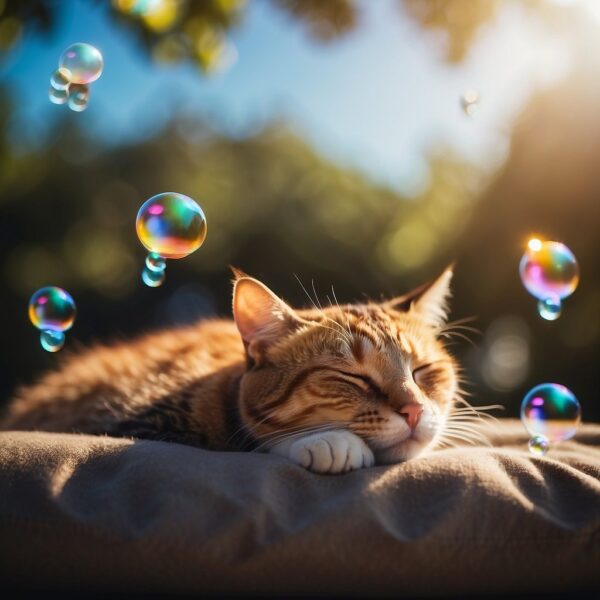
The Dreaming of Cats
Cats experience a complex dreaming process similar to that of humans, involving various sleep phases and dream content possibly linked to their daily lives. This section explores the intricacies of what occurs when cats enter the dream world.
Phases of Cat Dreams
Cats, like all mammals, cycle through different stages of sleep.
The Rapid Eye Movement (REM) sleep is the phase closely associated with dreaming, during which a cat’s brain activity surges and dreams are most likely to occur. Non-REM sleep comprises the other stages, where dreams can still happen but are less vivid.
Physical Manifestations of Dreams
During REM sleep, twitching and other movement may be observed in a sleeping cat.
Muscle twitches, twitching of the eyes, and even small vocal sounds indicate a cat’s entry into the dream state.
These physical manifestations are often likened to hypnic jerks in humans and are a normal part of sleeping.
Content of Cat Dreams
While we cannot know for certain, the content of cat dreams may involve daily activities like hunting or interacting with their humans and environment.
Common behaviors such as chasing mice or guarding their food bowl could play out within the subconscious storylines of their dreams.
Comparison with Human Dreams
Cat dreams are subjectively harder to analyze than human dreams; however, the scientific community agrees that both species experience a dream state due to similar brain activity patterns during sleep.
REM sleep, which in humans is associated with more vivid and narrative-driven dreams, is present in cats and likely serves a similar function for them.
Interpreting Cat Dreams
Interpreting the dreams of cats isn’t an exact science. However, observing a cat’s sleeping behaviors can provide insights into the emotional richness of their mind.
Twitching or movement may reflect a dream about a past hunt or exploration, suggesting that their dreams, like ours, blend memories, emotions, and images into a narrative somewhat disconnected from reality.
The Science of Cat Dreams
In the quest to understand if cats dream, scientific research and veterinary insights provide a glimpse into the feline mind during sleep.
Research on Feline Dreams
Noted neuroscientist Michel Jouvet’s pioneering experiments on cats at the University of Lyon revealed that when certain pathways in the brain were severed, cats entered REM sleep but displayed physical movements as if acting out their dreams.
This phenomenon, akin to what occurs in human REM sleep, indicates a possible dream state in cats.
REM sleep, characterized by rapid eye movements, is the sleep phase most associated with dreaming in humans.
Cats also experience REM sleep, which suggests the presence of dreams.
At the University of California, Davis, researcher Mikel Delgado delved into feline behavior and sleep patterns, adding evidence to the idea that cats dream.
While research has not conclusively deciphered the content of cat dreams, observations of twitching whiskers and paws, as well as small noises during REM sleep, support the idea that cats relive daily experiences in their dreams.
Veterinary Insights
Veterinary professionals, including Dr. Gary Richter, Rover’s resident veterinarian, note that the likeness of feline brain activity to humans implies the potential of dreams in cats.
Cats spend a considerable amount of time in sleep, which is essential for their predatory lifestyles; and this extensive sleep may contain dream cycles.
Mikel Delgado, a postdoctoral researcher at the University of California, Davis, and a certified cat behavior consultant, reinforces the notion that cats dream.
When veterinarian experts at an animal hospital observe cats during sleep, they see indications that the animals’ brains are processing the day’s events, potentially reflecting these experiences in their dreams.
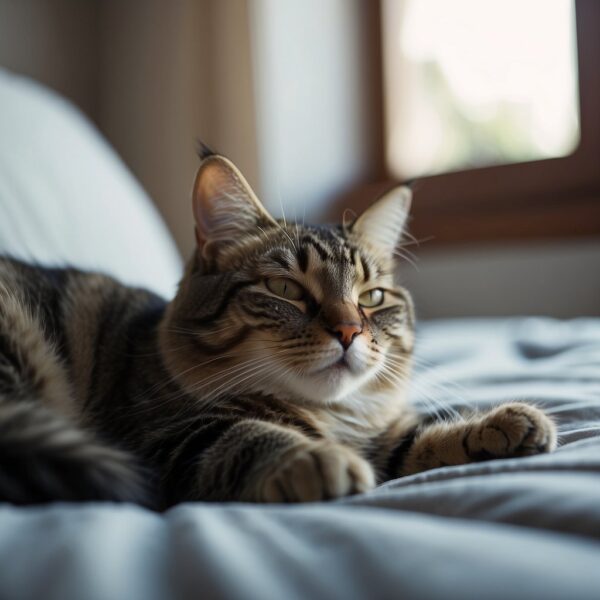
Cat Dream Behaviors
Similar to humans, cats experience various sleep cycles, including the REM (Rapid Eye Movement) phase, which in humans, is associated with dreaming. Observing a sleeping cat can offer insights into the possibility of feline dreams.
During sleep, especially within the REM cycle, cats may exhibit behaviors suggestive of dreaming.
For instance, a napping cat often displays:
- Twitching whiskers or paws
- Slight ear movements
- Rapid eye movement beneath closed eyelids
These subtle actions may hint at a cat’s dream content, possibly mirroring daytime activities such as hunting or playing.
It’s during these tranquil catnap moments that parents might wonder what flits through the minds of their slumbering pets.
While in a slumber, cats enter a relaxed state in which their bodies may react to the dreams they are experiencing.
Feline sleep can often be characterized by sudden motions, as if the cat is reacting to dream stimuli:
| Dream Phase | Common Behaviors |
|---|---|
| Light Sleep | Slow eye movements |
| Deep Sleep | Twitching, occasional soft vocalizations |
A typical cat nap often transitions into a deeper sleep state in which these dream behaviors are more likely to occur.
While the exact nature of what cats dream about remains a mystery, correlating their sleep behaviors with their active daily lives can provide a fascinating glimpse into their rest periods.
Sleep Disturbances in Cats
Sleep disturbances in cats can range from mild twitching to severe health issues. Recognizing these disturbances is crucial for the well-being of feline companions.
Nightmares and Restlessness
Cats may experience nightmares that manifest as twitching or sudden movements during REM sleep.
Observing your cat’s sleep patterns is important as frequent restlessness or signs of distress could indicate a problem.
- Symptoms to watch for:
- Excessive twitching
- Whisker or paw twitches
- Muffled vocalizations
Health-Related Sleep Issues
Sleep issues in cats can also be linked to health conditions.
Seizures during sleep, although different from dreaming, can sometimes be mistaken for nightmares.
It’s important to distinguish between normal twitching associated with dreaming and abnormal movements that could signal a medical concern.
- Common health-related sleep issues:
- Overactive thyroid
- Arthritis
- Cardiac conditions
Ensuring Healthy Sleep
Creating a comfortable and safe sleeping environment can greatly improve a cat’s quality of sleep.
A cozy cat bed away from noise and household commotion helps in establishing a serene space for your cat. Regular exercise and mental stimulation also contribute to better sleep patterns.
- Tips for a sleep-friendly environment:
- Soft, accessible cat bed
- Quiet, consistent sleeping area
- Routine physical and mental activity
When to Consult a Veterinarian
Cat parents should consult a veterinarian if their cat’s sleep disturbances seem out of the ordinary or are accompanied by other concerning symptoms.
Any noticeable change in sleep habits warrants a visit to an animal hospital or clinic for a thorough examination.
- Reasons to seek professional advice:
- Sustained unusual movement or vocalization during sleep
- Changes in sleep-wake cycle
- Signs of sleep disruption accompanied by behavior changes
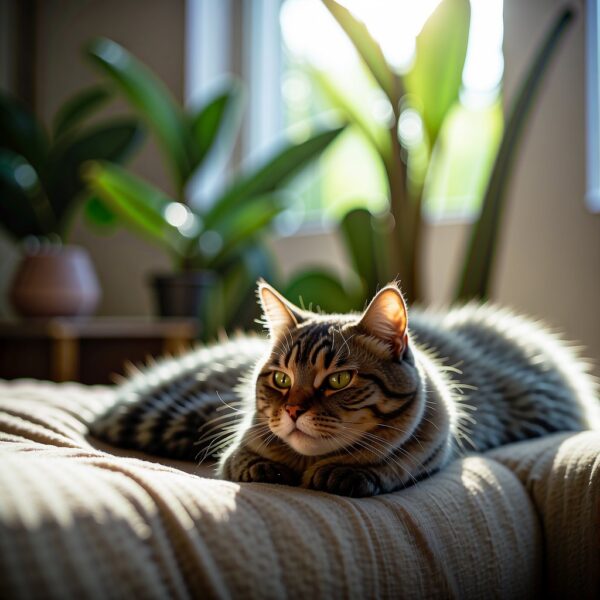
Cat Dreams and Physical Health
When observing a cat during sleep, one might notice physical signs indicative of dreaming.
Heart rate and breathing can fluctuate, often becoming more rapid, as if the cat is experiencing something exciting or stress-inducing within its dream.
During REM (Rapid Eye Movement) sleep, when dreams most commonly occur, cats’ bodies undergo various important repair processes.
This period is vital for maintaining overall health, aiding in the recovery of tissues and bolstering the immune system. A healthy REM cycle can leave a cat appearing happy and content upon waking.
| Sleep State | Heart Rate | Breathing | Indicators of Dreaming |
|---|---|---|---|
| Non-REM | Steady | Regular | Few twitches |
| REM | Variable | Irregular | Twitching, whisker and paw movement |
If a cat does not appear rested after sleep or shows signs of disturbed sleep patterns, such as excessive twitching or meowing, it may be worth consulting a veterinarian.
While some movement during sleep is normal, extreme agitation could point to health issues or stress.
Psychological Aspects of Cat Dreaming
Cats experience a sleep cycle similar to humans, complete with Rapid Eye Movement (REM) sleep, during which dreaming occurs. A cat’s mind is capable of creating dreams, and clinical psychologists take interest in studying these dreams to gain insights into the emotions and subconscious thoughts of felines.
| Studied Behavior | Indicative Emotion |
|---|---|
| Twitching of whiskers and paws | Active dreaming possibly reflecting instinctual hunting behavior |
| Soft purring or slight movement during sleep | Contentment or relaxed state |
Cats, like their human counterparts, display physical signs that suggest the presence of dreams.
An animal hospital may observe these behaviors as indicators of a cat’s mental state during rest.
The twitch of a paw or a slight flick of the tail might be a cat replaying its daily activities or instincts.
The subconscious mind of a cat, while not understood to the extent of human psychology, is thought to process emotions and experiences.
Dreaming may serve as a mental rehearsal for survival instincts such as hunting. Clinical psychologists and veterinary experts consider these dreams helpful for emotional regulation and processing daily events.
When assessing the psychological aspects of cat dreaming, one may postulate that dreams serve a similar purpose for cats and humans: consolidating memories and experiences.
This aspect ties the dreaming process to emotional well-being, providing an intriguing area of study for understanding the complexities of animal minds.
Cultural Perceptions of Cat Dreams
In various cultures, cats are often enveloped in an aura of mystery and spirituality, influencing how people perceive their dreams.
Dream interpretation sees cats as symbols with multilayered meanings, depending on the context of the dream and the culture.
In Western traditions, cats are sometimes associated with independence, feminine energy, and intuition.
Dreams about cats might be seen as a reflection of one’s personal power or a need for self-trust.
Conversely, in some Christian cultures, cats might carry a dual symbolism of healing and darkness.
They are creatures of the night, and their appearance in dreams could be seen as a warning or a call to recognize one’s hidden potential.
Literature often uses cats as characters that convey layered meanings.
They can represent slyness, grace, or supernatural insight. A culture’s literature, such as the iconic Cheshire Cat in “Alice’s Wonderland,” reflects the cultural significance and the enigmatic qualities that are attributed to cats.
Studies have noted that cat lovers often report dreams about cats more frequently.
Such dreams may arise out of the emotional bond between the cat and the parent, emphasizing affection and comfort or highlighting anxiety and concern for the animal’s well-being.
| Cultural Context | Common Perception in Dreams |
|---|---|
| Western | Independence, Intuition |
| Christian | Healing, Dark Secrets |
| Literary Icons | Slyness, Grace |
People’s personal experiences with cats in their waking life largely shape the content of their dreams.
In reviewing dream journals, one finds that recurring themes might include:
- Protection: Cats defending the dreamer from an unseen threat.
- Guidance: Cats leading the dreamer to an epiphany or realization.
While the interpretation of cats in dreams may vary widely, the review of cultural stories and content agrees that they hold significant symbolic weight across borders.
Practical Advice for Cat parents
When it comes to cats and their dreams, cat parents may observe their feline friends twitching, moving their paws, or making subtle noises while they sleep.
As confirmed by studies, it’s a common belief within the scientific community that mammals dream, and cats are no exception.
Ensuring Restful Sleep
- Comfortable Bedding: Provide a warm and cozy bed for your cat to enhance their sleeping experience.
- Quiet Environment: Reduce noise and disturbances to aid in uninterrupted sleep, which may promote a more fulfilling rest where dreams typically occur.
Recognizing Dream Behavior
- Observation: Notice signs of dreaming such as whisker or paw movements, similar to a dog dreaming. Cats may enter a REM phase, where dreams are more likely to happen.
- Non-disruption: Avoid waking your cat when they show signs of dreaming to ensure they get the full rest they need.
Promoting Positive Dreams
- Regular Exercise: Play with your cat to expend excess energy before sleep, which may contribute to a calmer, happier rest.
- Routine: Establish a consistent schedule for activities and rest. Stress-free environments tend to influence the emotional content of dreams.
Rover’s resident veterinarian might suggest that an emotionally stable and physically fit cat will likely have peaceful periods of sleep that could contain pleasant dream experiences.
While the specifics of a cat’s dreams are still a mystery, ensuring that they are healthy and secure is the best approach to foster positive dream scenarios.
Maintaining the emotional well-being of a cat is summarized in the concept that a happy cat is more likely to have pleasant dreams. Regular vet visits and daily affection from their human companions can contribute to the overall happiness of these beloved pets.
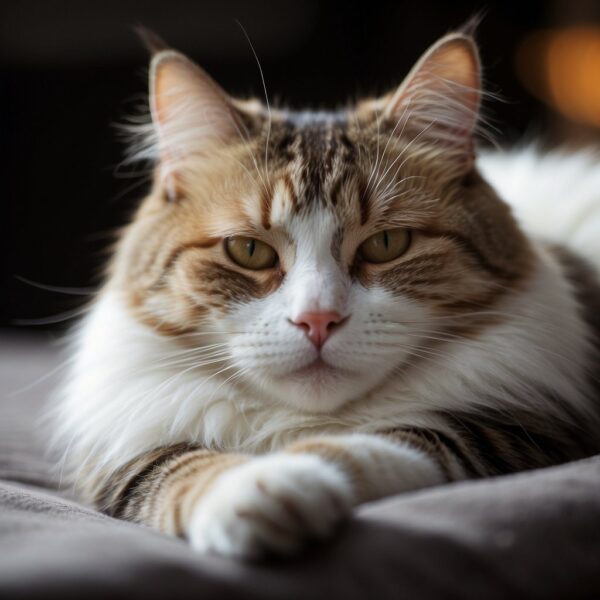
Frequently Asked Questions
In exploring feline dreams, common queries arise about what cats experience as they sleep. This section aims to address these questions based upon observations and scientific inquiry.
What do cats experience during their dreams?
Cats likely experience dreams that include activities from their daily lives.
Just as in humans, a cat’s brain goes through a REM (Rapid Eye Movement) phase where they are more likely to dream, possibly about chasing prey or exploring their environments.
Do our feline companions dream of their human caretakers?
While it’s impossible to know exactly what cats dream about, the strong bond they share with their human companions could suggest that parents may feature in their dreams, especially if daily interactions are significant and emotional.
What might provoke nightmares in cats?
Stressful experiences or trauma may result in nightmares for cats.
Noisy environments, changes in the household, or negative encounters with people or other animals can potentially lead to distressing dreams.
Is it possible that cats perceive dreams in color?
Cats’ vision is not as vibrant as humans’, but they can see some colors.
It’s plausible that their dreams also have some degree of color, particularly those they can see well in waking life, like blues and greens.
How do the dreams of indoor cats differ from those of outdoor cats?
Indoor cats may dream more about their indoor escapades and interactions, while outdoor cats could have dreams encompassing their outdoor experiences such as hunting or territorial defense.
Should a Cat Parent intervene if their cat exhibits twitching while asleep?
Occasional twitching during sleep is normal for cats, as it can be an indication of dreaming.
Parents should only intervene if the cat seems to be in distress or the twitching is excessive and out of the ordinary, signifying a possible health issue.